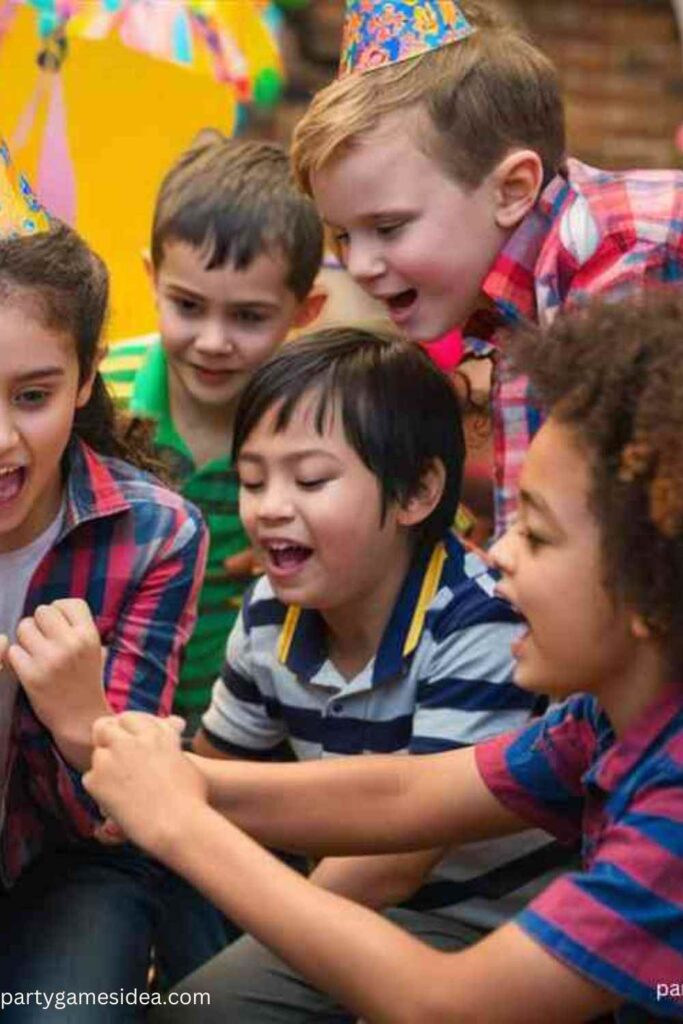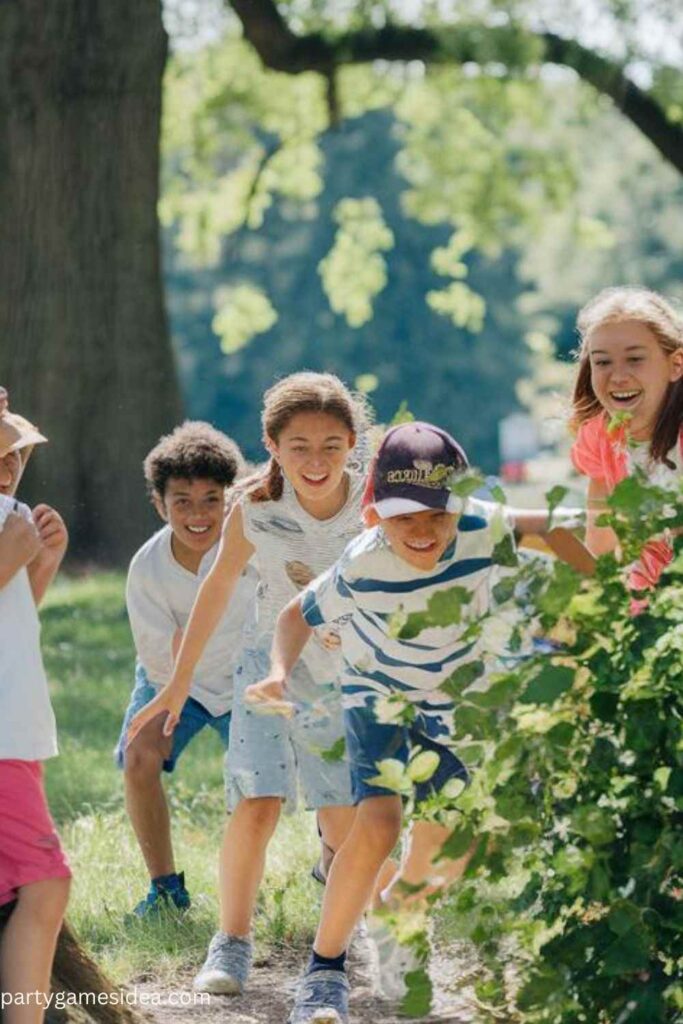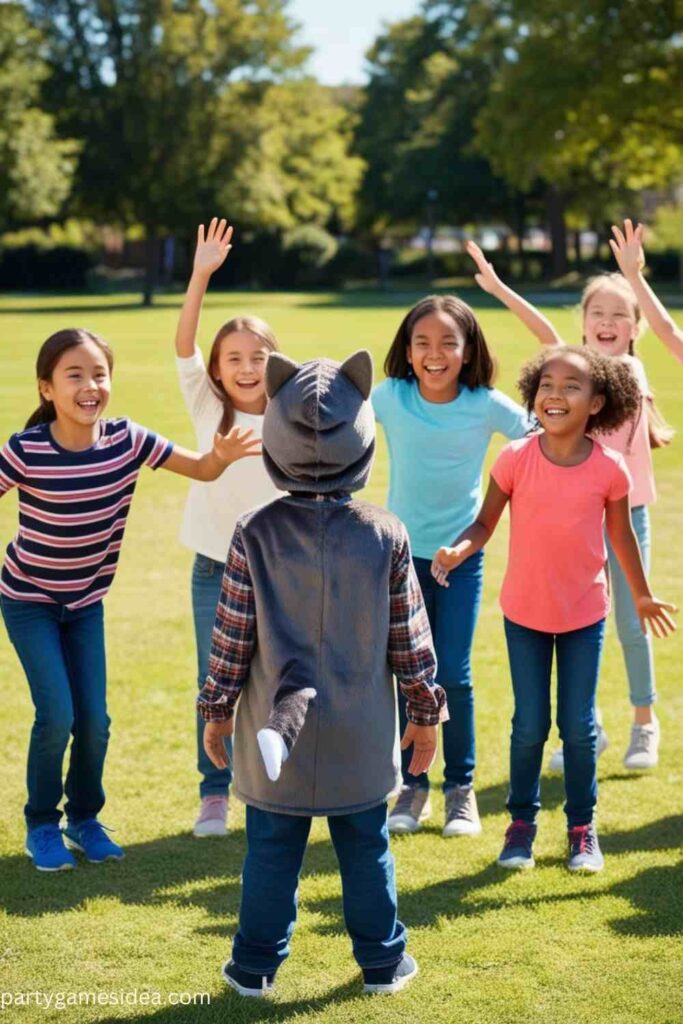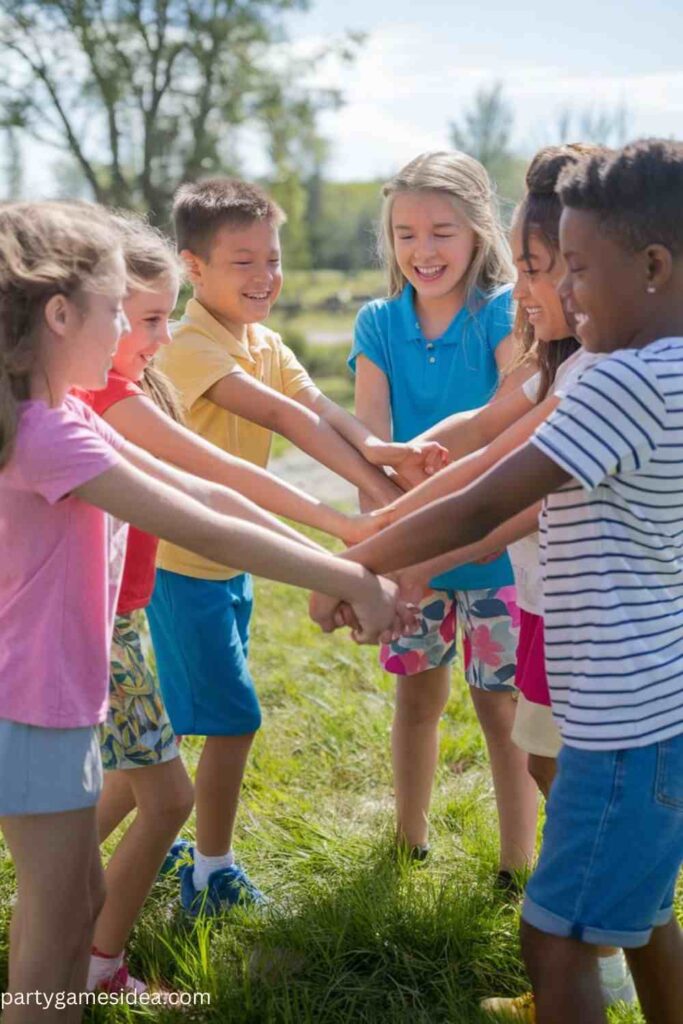Outdoor play is a crucial aspect of childhood development, offering numerous benefits that extend beyond physical exercise. Engaging in outdoor party games for kids without equipment encourages active movement, social interaction, and imaginative thinking. One of the greatest advantages of Outdoor Party Games For Kids Without Equipment is their ease of setup and execution. These games help children develop coordination, build teamwork skills, and boost their confidence through playful competition. Additionally, outdoor play fosters a connection with nature and provides a refreshing break from screen time, promoting overall well-being.
These games require minimal preparation and no special materials, making them accessible and convenient for any gathering. The simplicity of these activities allows children to focus on the fun and creativity of the game itself rather than on complex rules or expensive gear. By emphasizing creativity and imagination, Outdoor Party Games For Kids Without Equipment can be adapted to fit any space and tailored to suit the interests and abilities of the kids involved, ensuring a memorable and enjoyable experience for everyone.
Outdoor Party Games For Kids Without Equipment
Outdoor Party Games For Kids Without Equipment offer endless fun and creativity with minimal setup. These games encourage physical activity, teamwork, and imaginative play, making them perfect for any gathering. With just a bit of space and imagination, children can enjoy exciting and engaging activities without the need for special gear.
Tag
Tag is a classic game where one child is “it” and chases the others to tag them. Once tagged, the child becomes “it.”
- Rules: The child who is “it” must tag other players by touching them. Tagged players become the new “it.”
- Tips: Establish clear boundaries to keep the game safe and fun. Variations like Freeze Tag or Shadow Tag can add new twists.
Freeze Tag
In Freeze Tag, the player who is “it” tags others to freeze them in place until another player unfreezes them.
- Rules: When tagged, players must freeze until another player touches them to unfreeze them. The game continues until all are frozen or a set time limit ends.
- Tips: Encourage players to be creative with their frozen poses. Add challenges like moving in certain ways before tagging.
Duck, Duck, Goose Game
A traditional circle game where one child walks around the circle, tapping others and choosing who will chase them.
- Rules: The child walking taps heads and says “duck” until choosing “goose,” who must chase them around the circle. The first to sit in the empty spot becomes the new “it.”
- Tips: Ensure the circle is large enough for running. Adjust the pace based on the children’s energy levels.
Simon Says Game
Simon Says is a game where players must follow instructions only if prefaced by “Simon says.”
- Rules: The leader gives commands starting with “Simon says,” and players follow only those commands. If “Simon says” is not used, ignoring the command is correct.
- Tips: Keep commands simple and varied to engage all players. Use this game to practice listening skills and quick responses.
Kids Charades Challenge
Charades involves acting out a word or phrase without speaking while others guess what it is.
- Rules: One player acts out a word or phrase from a pre-determined category while others guess. No talking is allowed.
- Tips: Choose easy-to-guess words or phrases for younger kids. Encourage expressive gestures and creativity in acting.
Hide and Seek
Hide and Seek is a game where one player counts while others hide, and the seeker tries to find them.
- Rules: The seeker counts to a specified number while others hide. The seeker then searches for the hidden players, who must stay hidden until found.
- Tips: Set boundaries for where players can hide to keep the game safe. Encourage creative hiding spots and strategies.
Red Light, Green Light
In this game, one player calls “green light” for others to move and “red light” to stop. The goal is to reach the caller first.
- Rules: When “green light” is called, players move toward the caller. When “red light” is called, players must freeze. The first to reach the caller wins.
- Tips: Ensure players are aware of the rules for stopping quickly. Use clear and loud calls to avoid confusion.
What Time Is It, Mr. Wolf?
Players ask “Mr. Wolf” what time it is, and he responds with a number indicating how many steps to take. When “dinner time” is called, players run to avoid being tagged.
- Rules: Players ask “What time is it, Mr. Wolf?” and move based on the response. When “dinner time” is called, they must run back to the starting point without being tagged.
- Tips: Make sure Mr. Wolf is visible to all players. Change up the responses to keep the game exciting.
Human Knot Game
In this game, players stand in a circle, hold hands with two different people, and then work together to untangle themselves without letting go.
- Rules: Players hold hands with two different people and then work to untangle themselves into a circle without releasing hands.
- Tips: Encourage communication and teamwork. This game helps build problem-solving skills and fosters cooperation.
Follow the Leader
One player acts as the leader, and others must imitate their actions and movements.
- Rules: The leader performs various actions, and the followers must mimic these actions exactly. The game can continue with different leaders taking turns.
- Tips: Choose fun and varied actions to keep everyone engaged. Allow kids to take turns being the leader.
Scavenger Hunt
Players search for specific items or complete tasks based on clues or a list.
- Rules: Provide a list of items or clues, and players search for them within a designated area. The first to find all items or complete tasks wins.
- Tips: Tailor the list to the age group and environment. Include easy and challenging items to keep it interesting.
Nature Bingo
Create bingo cards with items found in nature. Players mark off items as they spot them during a nature walk.
- Rules: Players use bingo cards to find and mark off nature items. The first to complete a line or full card wins.
- Tips: Choose items that are common in the area. Make cards with different items for variety and fairness.
Group Juggle
Players stand in a circle and toss a ball or beanbag to each other, trying not to drop it.
- Rules: Players toss the object around the circle without dropping it. Each player should touch the object once before it returns to the starting player.
- Tips: Start with a slow pace and increase speed as players get comfortable. This game builds coordination and teamwork.
Simon Says
A game where players must follow commands only if preceded by “Simon says.” This helps in listening and quick responses.
- Rules: Commands are given starting with “Simon says,” and players must follow them. Commands without “Simon says” should be ignored.
- Tips: Use a mix of easy and challenging commands. This game helps develop listening skills and quick reactions.
The Floor is Lava
Players must avoid touching the ground when “lava” is called, using nearby objects or imagination to stay off the ground.
- Rules: When “lava” is called, players must find a way to stay off the ground. The last person to get off or anyone who touches the ground is out.
- Tips: Use safe objects or designated spots to avoid injury. Make sure all players are aware of the safety rules.
Crab Walk Race
Players race while walking in a crab-like position, using their hands and feet to move.
- Rules: Players walk on their hands and feet, facing upward, to race to a finish line. The first to cross the finish line wins.
- Tips: Ensure the race area is clear of obstacles. Adjust the distance based on the players’ age and skill level.
Animal Races
In this game, players mimic animal movements to race to a finish line, like hopping like a frog or waddling like a duck.
- Rules: Players choose an animal to imitate and race to the finish line using the chosen animal’s movement. The first to finish wins.
- Tips: Provide examples of different animal movements. This game encourages creativity and physical activity.
Musical Chairs (Without Chairs)
Players move around in a circle while music plays and must find a spot when the music stops. Without chairs, players use their imagination for where to stand.
- Rules: Players walk or dance in a circle when the music plays. When the music stops, they must find a designated spot to stand.
- Tips: Use a large, open space to ensure everyone has room. Adjust the size of the circle as needed for different group sizes.
Invisible Ball
Players pass an imaginary ball around the group, trying to keep the ball in motion without letting it drop.
- Rules: Players use their hands to simulate passing an invisible ball around the circle. The goal is to keep the ball moving and avoid dropping it.
- Tips: Encourage players to exaggerate their movements for fun. This game improves coordination and teamwork.
Copycat
One player performs a series of movements, and others must copy them exactly in order.
- Rules: The leader performs a sequence of movements, and the followers must mimic the sequence accurately. The game continues with different leaders.
- Tips: Start with simple movements and increase complexity as players improve. This game helps with memory and coordination.
Shadow Tag
Similar to regular tag but players must tag each other’s shadows instead of their bodies.
- Rules: The player who is “it” tries to step on other players’ shadows to tag them. Once tagged, players become the new “it.”
- Tips: Play during sunny times for clear shadows. Adjust the rules based on the shadow sizes and distances.
Follow the Leader
One player leads by performing various actions, and the rest of the group must follow and imitate these actions.
- Rules: The leader performs actions that the followers must copy exactly. The leader can change actions as they move around.
- Tips: Use a variety of movements to keep the game engaging. Allow different players to take turns leading.
Simon Says
In this game, players follow commands only if preceded by “Simon says.” This helps develop listening skills and quick reactions.
- Rules: Commands are given starting with “Simon says,” and players must follow them. Commands without “Simon says” should be ignored.
- Tips: Use a mix of easy and challenging commands. This game is excellent for practicing attention and response skills.
Human Knot
In this team-building game, players hold hands with two different people and work together to untangle themselves.
- Rules: Players form a circle, hold hands with two different people, and then try to untangle themselves without breaking the chain.
- Tips: Encourage communication and problem-solving. This game promotes teamwork and cooperation.
Freeze Dance
Players dance while music plays and must freeze in place when the music stops.
- Rules: When the music plays, players dance. When the music stops, they must freeze until the music starts again.
- Tips: Choose energetic music to keep the game lively. This game is great for improving coordination and listening skills.
Spaceship Landing
Players imagine they are astronauts landing a spaceship and must follow specific landing instructions or movements.
- Rules: The leader gives commands like “prepare for landing” or “brace for impact,” and players must perform corresponding actions.
- Tips: Use imaginative language and movements to engage players. Adjust instructions based on age and space available.
Animal Charades
Players act out different animals without speaking while others guess what animal they are imitating.
- Rules: One player acts out an animal, and others guess what it is based on the actions. No talking or sound effects are allowed.
- Tips: Choose animals that are easy to act out and guess. This game encourages creativity and physical activity.
Balloon Pop
Players use their bodies to pop balloons without using hands, creating a fun and active challenge.
- Rules: Players must pop balloons using only their bodies, like sitting on them or squeezing them. The game ends when all balloons are popped.
- Tips: Ensure the playing area is safe for popping balloons. Provide plenty of balloons for added fun.
Capture the Flag (Imaginary)
Players work in teams to “capture” an imaginary flag from the opposing team’s territory and return it to their base.
- Rules: Teams have imaginary flags placed in their territory. The goal is to enter the opposing team’s area, “capture” the flag, and return it to their base.
- Tips: Use clear boundaries for each team’s territory. Encourage teamwork and strategy in capturing the flag.
Ghosts and Shadows
Players mimic different spooky or playful movements and sounds, creating a fun and imaginative experience.
- Rules: One player is the “ghost” and performs spooky movements. Others imitate these movements to become “ghosts” too.
- Tips: Use creative and age-appropriate movements. This game fosters imagination and encourages playful interactions.
Hide and Seek with a Twist
Players hide and seek, but with a twist—such as specific hiding spots or roles.
- Rules: One player seeks while others hide. Introduce variations like hiding only in certain areas or adding roles like “seeker” or “ghost.”
- Tips: Adapt the rules based on space and the number of players. Encourage creative hiding and seeking strategies.
Shadow Puppets
Players use their hands to create shadow shapes on a wall or ground and guess what shapes they are making.
- Rules: Players use their hands to create shapes or figures that are projected onto a wall or ground. Others guess what the shapes represent.
- Tips: Provide examples of simple shadow shapes. This game encourages creativity and visual thinking.
Invisible Obstacle Course
Players navigate through an imaginary obstacle course, using their imagination to overcome challenges.
- Rules: Set up an imaginary course with obstacles like “mud pits” or “high fences.” Players must navigate through the course following the leader’s instructions.
- Tips: Use creative descriptions for obstacles. Adjust the difficulty based on players’ ages and abilities.
Counting and Hiding
Players count while others hide, and the goal is to find everyone before time runs out.
- Rules: One player counts to a set number while others hide. The seeker must find all hidden players within a given time limit.
- Tips: Set clear boundaries for hiding. Encourage creative hiding spots and quick counting.
Space Hop
Players pretend they are astronauts hopping on different planets, using their imagination to create a space-themed adventure.
- Rules: Players hop around as if on different planets, following space-themed commands or scenarios. The goal is to stay “safe” on each planet.
- Tips: Create imaginative scenarios for different planets. Encourage players to use their creativity in their space adventures.
Guess the Sound
One player makes a sound, and others must guess what the sound is.
- Rules: The sound maker produces a noise or sound effect, and others guess what it is. The player who guesses correctly gets to make the next sound.
- Tips: Use simple sounds that are easy to imitate. This game improves listening skills and creativity.
Storytelling Circle
Players sit in a circle and create a story together, with each person adding a sentence or detail.
- Rules: Each player adds a sentence or detail to a growing story, continuing around the circle. The story ends when everyone has contributed.
- Tips: Encourage creativity and imagination in story details. This game helps with language skills and group collaboration.
Magic Word
Players use a magic word or phrase to trigger certain actions, like jumping or spinning, creating a fun and interactive game.
- Rules: The leader says a “magic word” that triggers an action. Players must perform the action immediately upon hearing the word.
- Tips: Choose simple and fun actions for different words. This game promotes listening and quick reactions.
Movement Relay
Players perform a series of movements, like hopping or crawling, in a relay race format.
- Rules: Players complete a series of movements, one at a time, in a relay format. The next player starts their turn when the previous player finishes.
- Tips: Include a variety of movements to keep it engaging. Adjust the difficulty based on the players’ ages.
Freeze and Melt
Players move around until a “freeze” command is given, at which point they must hold a pose. When “melt” is called, they can move again.
- Rules: Players move freely until “freeze” is called, then hold their position. When “melt” is called, they resume movement.
- Tips: Use creative and fun poses for the “freeze” command. This game helps with body control and imagination.
Number Run
Players run to different numbers or markers called out by the leader, creating a dynamic and active game.
- Rules: The leader calls out a number or marker, and players run to it as quickly as possible. The game can include various challenges or tasks at each marker.
- Tips: Use clear and visible markers. Adjust the game’s complexity based on the players’ abilities and ages.
Magic Carpet Ride
Players pretend they are on a magic carpet and follow different movement instructions, like flying or hovering.
- Rules: The leader gives instructions for different “magic carpet” movements, and players must follow them. The instructions can include flying, hovering, or weaving.
- Tips: Use imaginative and descriptive language for movements. This game encourages creativity and physical activity.
Shape Shifters
Players use their bodies to form different shapes or figures, following commands from the leader.
- Rules: The leader calls out different shapes or figures, and players use their bodies to create these shapes. The game continues with new shapes or figures.
- Tips: Provide examples of simple shapes. This game enhances body awareness and creativity.
Story Charades
Players act out parts of a story or fairy tale without speaking, while others guess the story or character.
- Rules: The player acts out scenes or characters from a story, and others guess what it is based on the actions. No talking is allowed.
- Tips: Choose well-known stories for easier guessing. This game encourages imagination and physical expression.
Balloon Pop (Without Balloons)
Players imagine they are popping balloons and must act out the motions, such as using their bodies to pop an invisible balloon.
- Rules: Players mimic the actions of popping an imaginary balloon, like jumping or squishing. The goal is to act out the balloon popping motions creatively.
- Tips: Use exaggerated movements for added fun. This game promotes imagination and physical activity.
This list provides a variety of fun and engaging outdoor games that require no equipment, ensuring that kids can enjoy themselves anywhere with just a bit of creativity and imagination.
Physical Activity Games
Physical activity games are a fantastic way to keep kids active, engaged, and entertained during outdoor parties. These games not only provide a fun way for children to burn off energy but also help improve their coordination, teamwork, and social skills. Here are some classic physical activity games that require no equipment:
Duck, Duck, Goose
Intro: Duck, Duck, Goose is a timeless game that gets kids moving and laughing as they chase each other around in a circle.
- Basic Rules: Players sit in a circle, and one child walks around the outside, gently tapping each player on the head and saying “duck.” When they choose someone by saying “goose,” that person must jump up and chase the “it” player around the circle. The goal is to tag the “it” player before they can sit in the empty spot.
- Keeping It Engaging: To keep the game fun and engaging, encourage kids to come up with creative ways to run and tag. You can introduce variations like having the “goose” perform a funny dance before chasing or adding a theme to the game.
Red Light, Green Light
Intro: Red Light, Green Light is a high-energy game that tests kids’ listening skills and ability to stop and start on command.
- Instructions: One child is designated as the “traffic light” and stands at a distance from the other players. The “traffic light” calls out “green light” to signal players to move toward them and “red light” to signal them to stop. If a player is caught moving during “red light,” they must return to the starting line.
- Tips for Making It Exciting: To add excitement, vary the speed of “green light” and “red light” commands. You can also introduce challenges, like having players move in different ways (e.g., hopping, skipping) during “green light” or incorporating fun obstacles.
What Time Is It, Mr. Wolf?
Intro: What Time Is It, Mr. Wolf? is a playful game that combines movement with anticipation, as kids try to avoid being caught by the “wolf.”
- How to Play: One player is the “wolf” and stands at one end of the playing area, while the others line up at the other end. Players call out, “What time is it, Mr. Wolf?” The “wolf” responds with a number indicating how many steps forward the players should take. When the “wolf” calls “dinner time,” players must run back to the starting line without being tagged by the “wolf.”
- Variations for Different Age Groups: For younger kids, use simpler commands and a shorter distance. For older kids, increase the distance and add additional rules, such as requiring players to perform specific actions (e.g., hopping) when the “wolf” calls out a specific time.
Nature-Based Games
Nature-based games are a wonderful way to connect kids with the outdoors while engaging them in active and educational play. These games make use of the natural environment to inspire curiosity, exploration, and teamwork, turning an ordinary outdoor space into an exciting adventure. Here are some fun and creative nature-based Outdoor Party Games For Kids Without Equipment to try:
Scavenger Hunt
A scavenger hunt is a thrilling game that encourages children to explore their natural surroundings while searching for specific items or clues.
- Creating a List: Make a list of natural items for the kids to find, such as leaves of different shapes, rocks of various sizes, or specific types of flowers. You can also include clues that lead to hidden treasures or additional items.
- Hiding Clues: Scatter clues around the area that lead to the next item on the list or provide hints about where to find the next clue. Ensure that the clues are age-appropriate and consider the terrain when hiding items.
- Tips: Encourage teamwork by having kids work in small groups. Use a mix of easy and challenging items to keep the game exciting for different age groups.
Nature Bingo
Nature Bingo is a fun twist on the classic bingo game, where players search for specific items in nature to mark off their bingo cards.
- Creating Bingo Cards: Design bingo cards with different local flora and fauna, such as various types of trees, birds, or insects. You can create cards with images or names of these items.
- Playing the Game: As kids find each item in nature, they mark it off on their bingo cards. The first to complete a row or full card wins.
- Tips: Customize the bingo cards based on the local environment and the age of the participants. For added fun, include small prizes or rewards for winners.
Follow the Trail
Follow the Trail is an adventurous game where kids navigate a path marked with clues or challenges, fostering exploration and problem-solving skills.
- Setting Up the Trail: Create a simple trail in your outdoor area using markers like colored ribbons, chalk, or natural landmarks. At various points along the trail, place challenges or clues that guide the children to the next part of the path.
- Challenges Along the Way: Include fun activities or tasks at each checkpoint, such as identifying a plant, answering a nature-related question, or completing a physical challenge like jumping over a small obstacle.
- Tips: Make sure the trail is safe and appropriate for the age group. Adjust the complexity of the challenges based on the children’s abilities and encourage teamwork to solve the clues.
FAQ
What are the benefits of outdoor party games for kids without equipment?
Outdoor party games for kids without equipment offer several benefits:
- Promotes Physical Activity: These games keep kids active and moving, helping to improve their physical fitness and coordination. Running, jumping, and dancing contribute to overall health and well-being.
- Encourages Creativity: With no equipment required, children use their imagination to create scenarios and solutions, enhancing their creativity and problem-solving skills.
- Fosters Social Skills: Playing games that involve teamwork, communication, and following rules helps kids develop important social skills such as cooperation, empathy, and leadership.
- Boosts Cognitive Development: Many outdoor games involve strategic thinking and decision-making, which can enhance cognitive abilities and critical thinking.
- Promotes Inclusivity: These games can be easily adapted to suit various age groups and abilities, ensuring that all children can participate and enjoy the activity.
- Reduces Costs and Complexity: Without the need for special equipment, these games are cost-effective and easy to organize, making them ideal for spontaneous outdoor gatherings or budget-friendly parties.
- Enhances Emotional Well-being: Engaging in fun and active games helps reduce stress and anxiety, promoting a positive and enjoyable experience for children.
How can I adapt these games for different age groups?
To adapt outdoor party games for different age groups:
- Simplify Rules: For younger kids, use straightforward instructions and reduce complexity. For older kids, introduce more strategic elements and challenges.
- Adjust Difficulty: Modify tasks to match skill levels. For example, make distances shorter or obstacles easier for younger children.
- Change Roles: Allow older kids to take on leadership or challenging roles, while younger ones can handle simpler tasks.
- Modify Duration: Shorten game times for younger kids to match their attention spans, and extend or add more rounds for older children.
- Incorporate Themes: Use age-appropriate themes or variations to keep the game engaging and relevant to the participants.
Are these games safe for all outdoor environments?
Most outdoor party games are generally safe, but it’s important to consider the following to ensure a safe environment:
- Assess the Terrain: Ensure the playing area is flat and free of hazards like sharp objects, large rocks, or uneven ground to prevent injuries.
- Check Weather Conditions: Avoid playing in extreme weather conditions such as heavy rain, high heat, or lightning storms. Choose moderate weather for safety and comfort.
- Supervise Participants: Always have adult supervision to monitor play and address any potential safety issues promptly.
- Ensure Adequate Space: Make sure there is enough space for the games to be played safely without crowding or collisions.
By taking these precautions, you can help ensure that outdoor party games are enjoyable and safe for all participants.
How can I keep the kids interested and engaged in these Outdoor Party Games For Kids Without Equipment?
To keep kids interested and engaged in Outdoor Party Games For Kids Without Equipment, try these strategies:
- Add Variety: Rotate between different games to maintain excitement and prevent boredom.
- Incorporate Themes: Use themes or storylines related to the game to capture their imagination and interest.
- Include Challenges: Introduce new challenges or obstacles to make the game more stimulating and dynamic.
- Offer Rewards: Provide small rewards or incentives for participation and achievements to motivate kids and make the game more enjoyable.
- Encourage Creativity: Allow kids to come up with their own rules or variations to foster creativity and a sense of ownership.
- Engage Them Actively: Ensure all children are involved and have active roles to keep everyone engaged and prevent any from feeling left out.

Hi, I’m Hailey Say, the proud mom and owner of PartyGamesIdea.com. As a dedicated party designer and an expert in party ideas, I have a deep passion for crafting memorable and enjoyable experiences for every occasion. From holiday games to baby showers, bridal showers, bachelor parties, group gatherings, and more, I specialize in creating unique and fun party ideas that cater to all age groups and interests.
With an extensive collection of ideas ranging from printable games, teen and adult games, kids’ party activities, birthday party games, girls’ games, memory games, family games, and outdoor games, I aim to make every event special. My expertise also extends to themed parties such as dinner parties, brunch parties, graduation celebrations, college parties, and fun night games.
On PartyGamesIdea.com, I share my passion and creativity, helping people turn their party visions into reality. With years of experience and a keen eye for detail, I am committed to making your event planning process enjoyable and stress-free. Join me on PartyGamesIdea.com, and together, we’ll create unforgettable memories for you and your loved ones.










